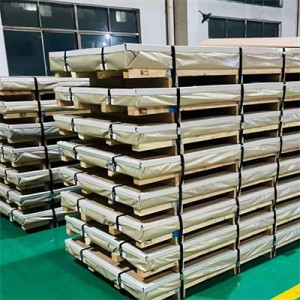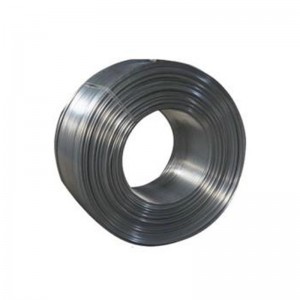2205 2507 904l Plate Stainless Sheets
Description
Austenitic stainless steel production process performance is good, especially chromium-nickel austenitic stainless steel, the production of special steel by conventional means can smoothly produce a variety of commonly used specifications of plate, tube, tape, wire, bar and forgings and castings. Because of the high content of alloying elements (especially chromium) and low carbon content, electric arc furnace plus argon oxygen decarburization (AOD) or vacuum deoxidation decarburization (VOD) method is used to produce this kind of stainless steel in large quantities. For small batch products of high grade, vacuum or non-vacuum non-induction furnace smelting can be used, and electroslag remelting can be added if necessary.


The stainless steel plate has a smooth surface, high plasticity, toughness, and mechanical strength, and is resistant to corrosion by acids, alkaline gases, solutions, and other media. It is an alloy steel that does not rust easily but is not rust-free.
Stainless steel plates refer to steel plates that are resistant to corrosion by weak media such as atmosphere, steam, and water, while acid-resistant steel plates refer to steel plates that are resistant to corrosion by chemically corrosive media such as acid, alkali, and salt. Stainless steel plates have been around since the early 20th century. centuries of history.
Stainless steel plate is generally a general term for stainless steel plate and acid-resistant steel plate. Introduced at the beginning of this century, the development of stainless steel plates has laid an important material and technical foundation for the development of modern industry and scientific and technological progress. There are many kinds of stainless steel plates and steel plates with different properties. It has gradually formed several categories in the process of development.
According to the structure, it is divided into austenitic stainless steel, martensitic stainless steel (including precipitation hardening stainless steel), ferritic stainless steel, and austenitic plus ferrite duplex stainless steel.
According to the main chemical composition of the steel plate or some characteristic elements in the steel plate, it is divided into chromium stainless steel plate, chromium-nickel stainless steel plate, chromium-nickel-molybdenum stainless steel plate, low-carbon stainless steel plate, high-molybdenum stainless steel plate, high-purity stainless steel plate, etc.
According to the performance characteristics and uses of steel plates, it is divided into nitric acid-resistant stainless steel plates, sulfuric acid-resistant stainless steel plates, pitting-resistant stainless steel plates, stress corrosion-resistant stainless steel plates, and high-strength stainless steel plates. According to the functional characteristics of the steel plate, it is divided into low-temperature stainless steel plate, non-magnetic stainless steel plate, free-cutting stainless steel plate, superplastic stainless steel plate, etc.
The commonly used classification method is to classify according to the structural characteristics of the steel plate, the chemical composition characteristics of the steel plate, and the combination of the two, generally divided into martensitic stainless steel, ferritic stainless steel, austenitic stainless steel, duplex stainless steel plates and precipitation hardening stainless steel plates can be divided into two categories: chromium stainless steel plates and nickel stainless steel plates.
Wide range of uses Typical uses pulp and paper equipment heat exchangers, mechanical equipment, dyeing equipment, film processing equipment, pipelines, exterior materials for buildings in coastal areas, etc.
The stainless steel plate has a smooth surface, high plasticity, toughness, and mechanical strength, and is resistant to corrosion by acid, alkaline gas, solution, and other media. It is an alloy steel that is not easy to rust, but it is not rust-free.
Specification
| Item | Stainless Steel Plate (Hot rolled,cold rolled) |
| Standard | ASTM A240,JIS4304-2005,ASTM A167,EN10088-2-2005,GB/T3280-2007, etc |
| Material | 304 ,316, 321, 317L, 310 , 347 , 904L.,Duplex 2205, Super Duplex 2507 |
| Surface | the surface and finish of stainless steel plate:2B,2D,BA,NO.1,NO.4,NO.8,8K,mirror,checkered,embossed,hair line,sandblast,Brush,etching,etc |
| Thickness | 0.01~200mm |
| Width | 1000mm,1219mm,1500mm,1800mm,2000mm,2500mm,3000mm,3500mm,etc |
| Length | 2000mm,2440mm,3000mm,5800mm,6000mm,etc |
| Package | Standard export package,suit for all kinds of transport,or asrequired. |
| Export to | USA, India, UAE, Saudi Arabia, Singapore, Iraq, Turkey, Indonesia |
Chemical Composition about stainless steel sheet
| Grade and Main chemical composition% | |||||||||
| C | Si | Mn | P≤ | S≤ | Cr | Mo | Ni | Other | |
| 201 | ≤0.15 | ≤1.00 | 5.5-7.5 | 0.06 | 0.03 | 16-18 | - | 3.5-5.5 | N≤0.25 |
| 202 | ≤0.15 | ≤1.00 | 7.5-10.0 | 0.06 | 0.03 | 17-19 | - | 4.0-6.0 | N≤0.25 |
| 301 | ≤0.15 | ≤1.00 | ≤2.00 | 0.045 | 0.03 | 16-18 | - | 6.0-8.0 | - |
| 303 | ≤0.15 | ≤1.00 | ≤2.00 | 0.2 | ≥0.015 | 17-19 | ≤0.6 | 8.0-10.0 | - |
| 304 | ≤0.08 | ≤1.00 | ≤2.00 | 0.045 | 0.03 | 18-20 | - | 8-10.5 | - |
| 316 | ≤0.08 | ≤1.00 | ≤2.00 | 0.045 | 0.03 | 16-18 | 2-3 | 10-14 | - |
| 430 | ≤0.12 | ≤0.75 | ≤1.00 | 0.04 | 0.03 | 16-18 | - | ≤0.6 | - |








